After a restful night's sleep Tom and I arose perky and ready to go at 5:30AM. (Much to the chagrin of my in-laws!) We set out first thing to explore the hutong (historic neighborhood) around our hotel. I was intrigued by the maze like structure, “make do” mentality, and sheer tightness of the living quarters. While more modern Beijingers live in high rise apartment buildings, historically they lived in these hutongs. Back in the day one family would own a large courtyard with surrounding buildings, which would then be attached to another families courtyard and buildings. However, during the first part of the 20th century when the dynastic reign of China fell, the economy of Beijing plummeted and the hutongs were subdivided and subdivided into many tiny little parts. The number of households nearly doubled- whiled the space remained the same.
Bikes and mopeds are abundant in Beijing, as are cars. But in the hutongs cars are more rare, because they don't fit down some of the narrower alleyways. The bikes you see here are much nicer than most of the ones we saw being used. The streets are lined with bikes that have been deserted and are rusted skeletons of their prior selves.
Being the gardener that I am, I'm always interested people's gardens. Most of the ones I saw in Beijing were like this, grown out of pots- old containers, lining one's home or courtyard.
It's scenes like these that make me want to be better at “Getting what I want, out of what I have.” Walking around Beijing definitely made me rethink my “needs” regarding our new home in Seattle. (Do I really need a large yard? How many bathrooms do I need- In many of these hutongs people don't have their own bathroom facilities, but rather share a public bathroom with the community.)
Mote surrounding the Forbidden City aka Palace Museum
The weather condition for yesterday was described haze. I'm not sure if it was just fog, or air pollution but it certainly added to the mystical quality of Beijing.
Our hotel was just a few blocks from the Forbidden City and so just walked over after breakfast.
We, by chance, walked by this watch tower on the south-east corner, its known for its ornate workmanship.
Before we headed into the Forbidden city we visited Tianneman square. Which was, unfortunately, mostly closed do to a visiting head of state from Palestine. It's a huge square and is generally throning with people, but on this occasion only one small section was open for viewing. It, like everything in Beijing, is in grand scale. It's the largest public square in the world.
Walking towards the Forbidden City, this gives you a sense of the scale.
Here's our group! Tom and I and my amazing in-laws Pam and Stan.
The Forbidden City is distinguished from the rest of the city by it's beautiful gold roofs and red buildings. (Much of Beijing is gray.) The paintings that cover all the ceilings and cove work is brightly painted in blues, yellows, and reds. It's very majestic.
This is one piece of stone that was transferred by dragging it over ice over something like a 13 year period. Only the Emperor would walk down this path.
These intricately carved posts are all over the palace museum. Some are dragons others phoenix. The detail is still so prevalent after hundreds of years of decay.
Two of these dragons straddle the path leading up to the Emperor's quarters. One is male the other female, representing the balance of yin and yang. There is great symbolism in most of the architectural details. Dragons symbolize power, cranes longevity. 10 is considered the number of God, perfection. 9 then was the number of the Emporer because he was considered the son of heaven. There are always nine decorative gold orbs in 9 rows on these huge doors that separate each part of the complex.
 On most of the doors the orbs are gold, but people rub them believing it will bring them financial luck, so apparently these have been rubbed bare!
On most of the doors the orbs are gold, but people rub them believing it will bring them financial luck, so apparently these have been rubbed bare!I had heard many stories about the masses of people that throng China's most famous sites, so expecting more, the number of people felt very comfortable. It was interesting, however, to be one of the few Caucasians. We've seen/met very few Americans so far. It seems most Americans come to China via tour groups.
At the end of our tour, our tour guide took us into this gated off area of the city. She showed us pictures of Puyi as a young boy, and told us about his life during the Republic. She explained that because of his rendezvous with harlots Puyi contract a disease which prevented him from bearing children. His closest descendant, and thus the heir to his throne, is his nephew. She then explained that “today you are going to get a chance to meet his nephew. .. ” We walked into this back room decorated with beautiful chinese scrolls, calligraphy and antique carvings and there he was, a respectful looking man, reading at a large desk. In front of him, a collection of calligraphy supplies. It was interesting because despite the fact that this man holds no power now, I felt a certain reverence in the room. The tour guides certainly respected the fact that if the empire still reigned, this man would sit on the throne. It was a very special experience. He then proceeded to paint a beautiful calligraphy of “happiness” with his signature and “in the Forbidden City” with his signature stamp, and a good luck stamp. We'd all hoped to watch someone do calligraphy, but we certainly didn't expect that person to be the nephew of the last emperor!
Just north of the Forbidden City is the Palace Gardens. The peony trees were in full bloom, and in aromatic splendor. The last emperor Puyi worked in these gardens at the end of his life, after returning from exile. (As dramatized beautifully in “The Last Emperor.”)
The last emperor and his first wife took wedding photos in front of these twin cypress trees believing they were good luck for a long and love-filled marriage.
Forbidden City viewed from the Drum Tower. I love how you can see the city disappearing into the mist.
The Forbidden city was certainly marvelous. It's amazing to think of the amount of time, wealth, and human man power that went into the building and maintaining of this gigantic complex.
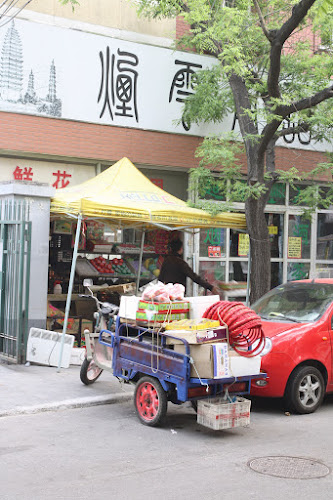


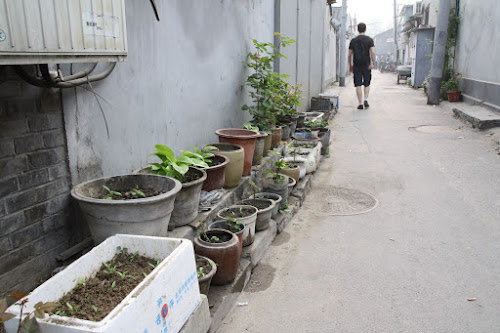


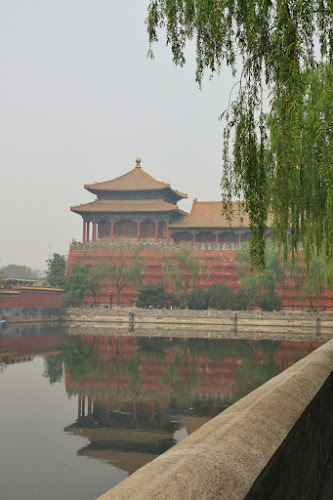

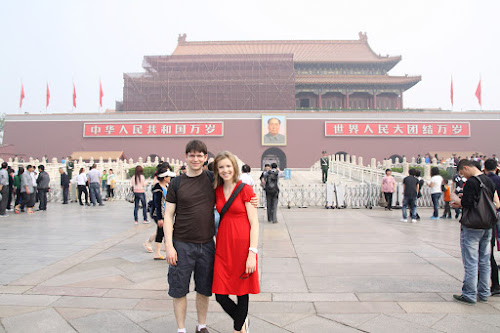
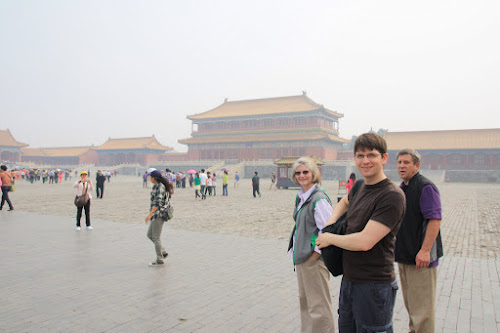

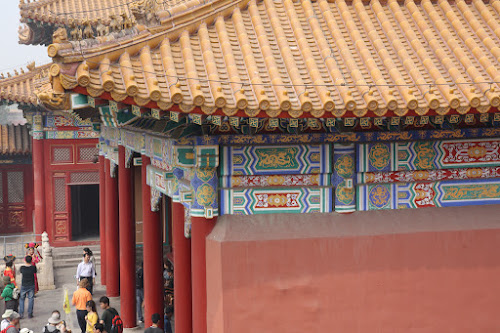
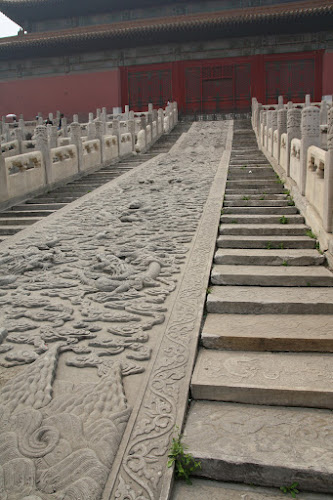
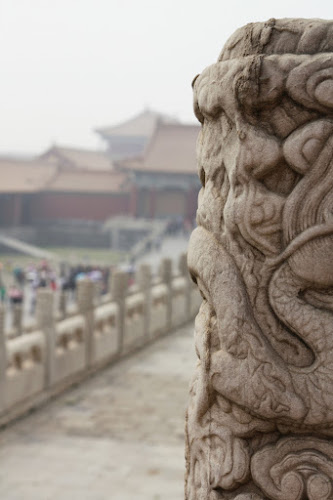



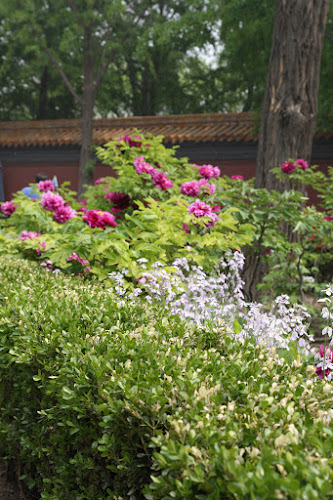
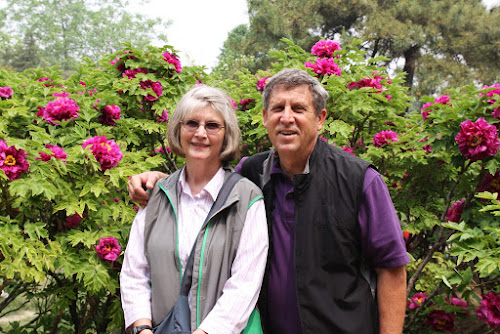
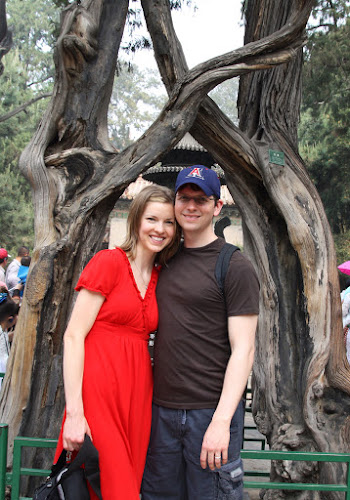
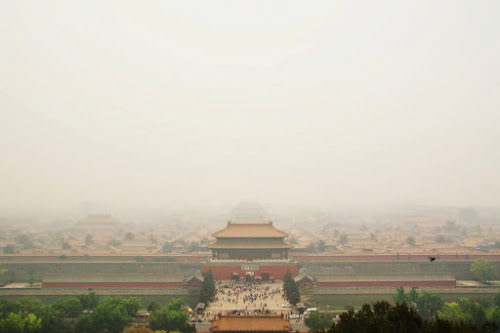
One response to “Beijing!”
Hi Kjirsti, Thanks for sharing your experience. China is on our bucket list. Come and visit us in Edmonton, AB. We miss you guys!
Erik